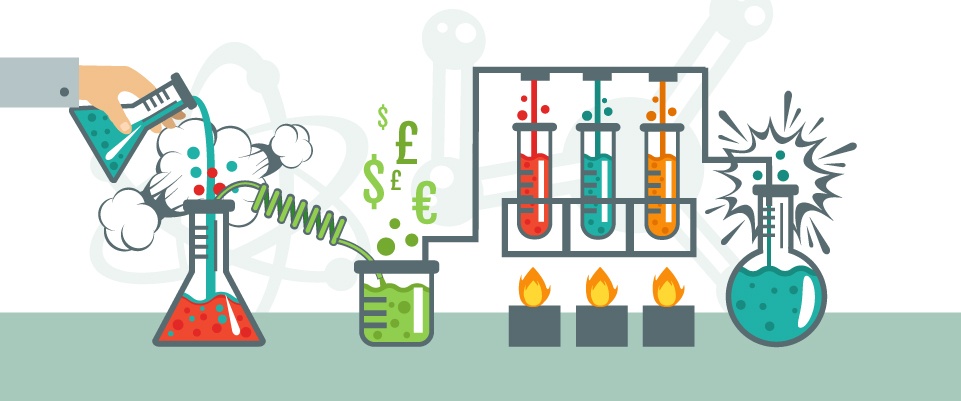Small improvements to your SaaS pricing strategy can have a huge impact, on customer signups, MRR, and the overall growth of your business.
Trouble is, working out how to improve your pricing strategy can feel seriously complicated: you need to factor in your competitors' pricing, the perceived value of your solution, the price sensitivity of your customers... and somehow come up with a perfectly optimised price.
Thankfully, big journeys start with small steps. To help you improve your software pricing, I asked a ton of founders, CEOs, CMOs, advisers and VCs to share their best SaaS pricing strategies, and answer a simple question:
"What is your #1 tip for improving your pricing strategy?"
Read on for killer pricing insights and smart SaaS pricing strategies from the likes of Wade Foster (Zapier), Adam Feber (Chargify), and Lincoln Murphy (Sixteen Ventures).
A lot of companies choose pricing randomly or by just looking at competitors.
But pricing should be approached with the same thoughtfulness and systematic thinking that we do for product strategy, business model, and other elements of our business.
You need to take into account your target audience, economics of your distribution channel, among other things to come up with a thoughtful hypothesis.
Brian Balfour, Coelevate, Founder/CEO, Reforge
Pricing needs to be thought about through a framework that is customer focused. Too many companies sit in a room and simply guess and check to come to their pricing, which inevitably leads to a significant amount of money being left on the table.
Instead, your research framework should leverage data collected from your target customers to “quantify” your buyer personas and understand who they are, what they want, and ultimately how much they're willing to pay for what they want from your product.
Utilizing this type of customer data prevents you from selling the wrong product to the wrong pricing, which leaves an enormous amount of cash on the table."
Patrick Campbell, CEO, Price Intelligently
Experiment. Don't be afraid to try new price points.
You'll learn how the conversion rates change and get a feel for the price elasticity of your product.
You can always grandfather customers too, to make sure the price changes don't accidentally upset current happy customers."
Wade Foster, CEO/Co-founder, Zapier
100% it is to start with the customer!
Understand who you’re selling to, what they need to accomplish (their Required Outcome), how they need to accomplish that (their Appropriate Experience), and what value they’ll get when they achieve that Desired Outcome (Required Outcome + Appropriate Experience).
By really getting to know your customers like that, you’ll also start to figure out the core “value metric” your pricing should be architected around (seats, consumption, etc.), how they need to buy, land and expand potential within customer segments, etc.
When it comes to pricing, start with your customer; after all, they’re the ones paying you!"
Lincoln Murphy, Sixteen Ventures
"While there is a ton of research that goes into a pricing strategy, the only true test is how users react. Because of this, run a test every few months to see what works and what doesn’t. But before you start running tests:
1) A pricing strategy isn’t always about changing your price. It can include adding (or removing) a freemium offer, changing the duration of a trial, or hiding/killing your lowest priced plan (this plan typically has the highest churn).2) Before you can do any testing, you need to track and understand your baseline metrics. If you can not recite keys stats such as conversion rate, churn, average revenue per user/account, lifetime value, etc., then start there before you do anything!Keep in mind, not every test will be successful. Sometime it's hard to do work and feel like you failed, but don’t be afraid to revert back to a previous configuration. Keep testing and you will eventually find experiments that move the needle in the right direction.” Adam Feber, Marketing Director, Chargify
1) When deciding your pricing, don't base it on your direct competitors' price: base it on the value you are providing to your client (in terms of added revenue, or reduced costs, including cost of time).
Nicolas Jacobeus, CEO/Founder, Scale2) Showing them the profit they are going to make by using your product (we developed an ROI calculator for this purpose) allows you to use price anchoring to make it easier for them to see that price as an investment, rather than just a cost.3) Don't be afraid of choosing a price even if you are not confident about it yet because of a lack of metrics/data; the price is part of your offering, so the most important thing is to have feedback on that as soon as possible. You can always change it later and grandfather the early price."
My #1 tip for pricing strategy is to treat it as an experiment. Don't kid yourself, your teammates, and your customers, by thinking you'll discover the perfect pricing strategy just by thinking about it.
Instead, treat it like a product feature. Define what success means, in a really concrete, objective, quantifiable way. What does a good funnel look like with the right pricing strategy in place?Then, keep experimenting. Change the pricing strategy often, if needed, until you get the signup, engagement, and retention metrics you defined above. Yes, experimentation may be a bit more time-consuming than a product feature, but it's at least as important here as elsewhere.When experimenting, be good to your existing customers. Always grandfather them into the plan/pricing strategy most beneficial for them. You're solving for the next millions in revenue, not trying to squeeze out more from the early supporters."Yoav Shapira, Product/Engineering,
HubSpot, CarGurus, Happier, Jana, yoavshapira.com
Make sure that you understand that pricing is a marketing exercise. It's about deciding where your product or service will sit on the value spectrum of solutions available to your customers.
Be very clear about the value that you deliver to your customers and then align your pricing with that. There'll always be customers that want it to be cheap/free and also those who want to pay you much more for you to change your offering. Don't do either of those things. Know you value, set your price and stick with it."
Ryan Baker, CEO/Co-founder, Timely
"Always have an upsell.
If you have customers who are spending money for your software, then there is always going to be a percentage of them willing to spend even more in order to have the problem solved more completely or more easily.
Whether it is a higher pricing tier, add-on services, whatever, it is crucial to the success of any SaaS business that you have a way for customers to spend more money with you. This isn't to suck out every penny from your customers and it shouldn't be a gimmick where they pay more without getting more. Find ways to give your customers more value and then charge accordingly.
Not only will this increase your MRR without needing new customers, but an increased CLV makes it much easier to grow with paid acquisition or even a traditional sales team. The more value you can provide your customers, the more you can charge your customers, and the more you can profitably spend to acquire more customers."
Andy Baldacci, Marketing Director, Hubstaff
"Quantifying your buyer personas is integral to a great pricing strategy.
Most SaaS companies now know they’re supposed to use buyer personas to narrow down their customer acquisition focus. But almost all make these only qualitative, with demographic and personality profile information. This means these buyer personas aren’t really actionable.
We started to use quantified buyer personas after our friend Patrick Campbell at Price Intelligently showed us how crazy efficient they are to narrow the focus even further. They boost these customer profiles with actionable data, such as feature value analysis, willingness to pay, and unit economics.Once you know what customers want, how much they are willing to pay, and how much they’ll cost to acquire, then your pricing strategy will start to fall into place."
Walter Chen, Co-founder, IDoneThis
The best thing you can do to improve SaaS pricing strategies is experiment, measure and repeat.
Experiment, testing different pricing tiers, raising or lowering your price, or using a different pricing model. Measure before you make any changes to give yourself a benchmark against which you measure the results of your experiments. And repeat: aim to review a few times a year, to take into account any changes you’ve made to your SaaS product that impact the amount of value it’ll bring to your customers, the change in the market, and your customers' changing needs.
The worst thing you can do is just to set-and-forget your pricing. You need to treat it as a constant work in progress – your pricing strategy will never be perfect because your competitors, the business environment and your customers’ requirements change over time.
Emily Smith, Growth Specialist, Cobloom
Startup’s pricing strategies should be explicit.
They should decide which strategy to pursue, and align sales, marketing, product and engineering efforts along those lines.
Madhavan Ramanujam, a pricing expert and partner at Simon-Kucher partners, recommends polling your executive team to prioritize revenue growth, volume growth, profit generation, and market share to ensure the company’s pricing strategy is consistent with the goals of the team."
Tomasz Tunguz, tomtunguz.com, VC, Redpoint
"1) When you're small, test massive changes. The smaller you are, the easier it is to test crazy hypotheses without alienating a ton of existing customers. Want to get started on something now? Go and double your pricing.
2) When you're big, optimise. With a decent customerbase, even tiny improvements to SaaS pricing strategies will have sizable returns. Something as simple as reordering your pricing packages, or changing the last digit of your price, can make a real difference to MRR.
3) Never stop experimenting. There's no such thing as a 'perfect price'. Even if we could optimise price for a given snapshot of time, your business isn't static, and new customers, features and ideas mean that your perfect price changes alongside.
Ryan Law, CMO/Co-founder, Cobloom
"Pricing does not emerge out of thin air. It’s not something that you tack on just before you “go live”. And it’s not something you cook up just because you’d feel odd leaving your pricing page blank.
For one thing - and this is fairly obvious - your pricing needs to make sense for your business model. Unless you’ve found some other revenue source or you’re a philanthropy, you probably need to charge enough for your product to at least cover your costs.But there’s a less obvious consideration too. The pricing strategy needs to fit with your value proposition. Without going into lots of marketing mumbo-jumbo, the “value proposition” answers a few simple questions about your company and your solution:
- What do you sell?
- Who should buy it?
- What problem does it solve, and how costly is that problem?
- Why is it better than alternatives, including doing nothing?
The pricing strategy and the value proposition need to be in sync.To illustrate, if your solution solves a problem that most people can live with, and isn’t much different than a bunch of alternatives, then you probably won’t get many people to pay you much for it. And by the way, the fact that it’s built with awesome technology doesn’t really matter much.On the other hand, if your solution solves a huge problem, it's 1000 times better than anything else available, and your prospective customers can pay a lot of money for a solution… well that makes for a much different (and more lucrative) pricing strategy.So here’s my #1 tip for SaaS pricing strategies:Until you have formulated a compelling value proposition, don’t try to develop a pricing strategy. Unless a customer can see some value in your solution, they probably won’t buy it. No matter how well-crafted your pricing strategy, if it’s not in sync with your value proposition, you’ll end up with lipstick on a pig.Peter Cohen, Managing Partner, SaaS Marketing Strategy Advisors
For us the key to pricing has been A/B testing to measure Conversion Rates and Churn Rates at different price points.
We've learned that there is a range of price insensitivity (where we can reduce prices but not grow faster) so we want to be at the top end of that range, as well as low entry pricing (where we get lots more subscribers, but they tend also to churn faster, which ultimately doesn't help us grow faster). There's a price point at which people will say "Sure let's try this, its not much money to commit." But then they are more likely to churn.We aim to attract users who value the service, and invest in giving REALLY great customer service and helping them be really successful with our service. Because our long term growth depends on attracting customers that retain. So that means our Pricing Strategy has to be aligned with our User Onboarding strategy.Paul Boyce, CEO/Co-founder, Popcorn Metrics
For SaaS products, the #1 tip for improving your pricing strategy is to understand the different customer cohorts your product has, and then to offer tiers that allow the customer to self-select into the appropriate offering.
This strategy allows you to provide not only the most value to your customers, but also increase your overall revenue by minimizing money you might otherwise be leaving on the table.
You can further optimizing your tiered approach through trials -- but pay attention to the cost for the additional offerings. If the extra support costs aren't recouped, you may be better off looking at ways to increase your price & grandfathering in your existing customers for an appropriate amount of time.
Tushar Kirtane, Product Manager, Pocket
Most SaaS companies fail to invest enough into their pricing strategy. A study done by the Harvard Business Review demonstrated that a 1% improvement in price results in a 11.1% increase in operating profit. So the ROI is there!
My biggest tip for improving your pricing strategy is therefore simple: prioritise it.
Treat your pricing as a core part of your growth strategy. Agree to commit a certain level of time to your pricing strategy every month. Set-up a monthly meeting purely to discuss pricing, pricing tests, and new ideas.
Just by giving pricing the priority it deserves, you'll see tremendous results, and fast.
Will Steward, CEO/Co-founder, Cobloom
Improving SaaS Pricing Strategies
Even small improvements to your pricing strategy can have a transformative impact on your revenue.
But thanks to the expert guidance and tried-and-tested SaaS pricing strategies outlined here, you'll be able to make some quick and effective changes to your own pricing.
With a 1% increase in price yielding an incredible 11% increase in profit, most SaaS pricing strategies are leaving a lot of money on the table - but there's no reason you need to fall victim to the same problems of under-valuing and miss-selling.


 A lot of companies choose pricing randomly or by just looking at competitors.
A lot of companies choose pricing randomly or by just looking at competitors. Pricing needs to be thought about through a framework that is customer focused. Too many companies sit in a room and simply guess and check to come to their pricing, which inevitably leads to a significant amount of money being left on the table.
Pricing needs to be thought about through a framework that is customer focused. Too many companies sit in a room and simply guess and check to come to their pricing, which inevitably leads to a significant amount of money being left on the table. Experiment. Don't be afraid to try new price points.
Experiment. Don't be afraid to try new price points. 100% it is to start with the customer!
100% it is to start with the customer! "While there is a ton of research that goes into a pricing strategy, the only true test is how users react. Because of this, run a test every few months to see what works and what doesn’t. But before you start running tests:
"While there is a ton of research that goes into a pricing strategy, the only true test is how users react. Because of this, run a test every few months to see what works and what doesn’t. But before you start running tests: 1) When deciding your pricing, don't base it on your direct competitors' price: base it on the value you are providing to your client (in terms of added revenue, or reduced costs, including cost of time).
1) When deciding your pricing, don't base it on your direct competitors' price: base it on the value you are providing to your client (in terms of added revenue, or reduced costs, including cost of time). My #1 tip for pricing strategy is to treat it as an experiment. Don't kid yourself, your teammates, and your customers, by thinking you'll discover the perfect pricing strategy just by thinking about it.
My #1 tip for pricing strategy is to treat it as an experiment. Don't kid yourself, your teammates, and your customers, by thinking you'll discover the perfect pricing strategy just by thinking about it. Make sure that you understand that pricing is a marketing exercise. It's about deciding where your product or service will sit on the value spectrum of solutions available to your customers.
Make sure that you understand that pricing is a marketing exercise. It's about deciding where your product or service will sit on the value spectrum of solutions available to your customers. "Always have an upsell.
"Always have an upsell.
 The best thing you can do to improve
The best thing you can do to improve 

 "Pricing does not emerge out of thin air. It’s not something that you tack on just before you “go live”. And it’s not something you cook up just because you’d feel odd leaving your pricing page blank.
"Pricing does not emerge out of thin air. It’s not something that you tack on just before you “go live”. And it’s not something you cook up just because you’d feel odd leaving your pricing page blank. For us the key to pricing has been A/B testing to measure Conversion Rates and Churn Rates at different price points.
For us the key to pricing has been A/B testing to measure Conversion Rates and Churn Rates at different price points.
 Most SaaS companies fail to invest enough into their pricing strategy.
Most SaaS companies fail to invest enough into their pricing strategy. 

